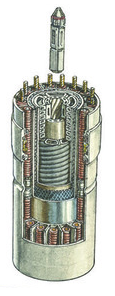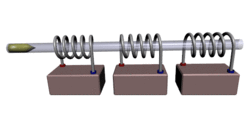User:BaconShelf/Sandbox5
From Halopedia, the Halo wiki

- Nils Thune: "Space? Those things even make noise in zero-gee?"
- Ponder: "If you’re inside a MAC ship when the cannon fires? I don’t know if you’re a religious man, Governor. But it’s a little like a church bell—"
- — Governor Thune and Captain Ponder discussing MACs.[1]
The magnetic accelerator cannon[2], also referred to as a mass accelerator cannon[1] or MAC, is a type of heavy weapon system employed by humanity, primarily the spacecraft of the United Nations Space Command. Within the UNSC, MACs are defined as a heavy weapon that fires a sizeable ferric-tungsten round at supersonic velocities from the bow of a capital ship, orbital defense platform or mounted driver emplacement.[3] MACs are coilguns employing Asynchronous Linear Induction Motor (ALIM) technology[3] and are typically used in military applications, though similar technology can be used in civilian mass drivers for industrial use.
Overview
MACs are fitted as a standard armament on most UNSC Navy vessels, ranging from small Gladius-class corvettes to Marathon-class heavy cruisers and even carriers or refit civilian ships such as the Phoenix-class colony ship. With a handful of exceptions, MACs are typically spinally-mounted, meaning that the entire ship is built around the gun, with the cannon running a significant portion of the length of the ship's stern. However, the technology is not exclusively used in spinally-mounted MAC guns, with naval autocannons (themselves sometimes referred to as "MiniMACs")[2] and even ground-based weapons such as the M68 Gauss cannon and M99 Stanchion operating on the same principle.[1]
Operation

MACs operate on the basis of a coilgun. When firing, a series of stacked asynchronous linear induction motors are sequentially activated, propelling a projectile with vast amounts of kinetic energy.[2] The construction of the weapon takes the form of a series of coiled conducting wires (or solenoids). When a solenoid is activated, the projectile is attracted to the coil. As the projectile reaches the coil, a second coil is activated, attracting the projectile further down the barrel of the gun. This process is repeated as the projectile travels the length of the gun, with each successive solenoid accelerating the projectile to higher and higher velocities. As such, the longer a MAC's length is, the faster the muzzle velocity of the fired projectile.
This process differs from that of a railgun - a similar weapon system which feeds electrical current through a projectile to accelerate it along two conducting rails.
To fire a MAC, UNSC ships must draw power from the fusion reactor into a series of capacitors, storing the generated energy for firing. As such, charging the MAC draws power away from other sub-systems such as engines. As such, a MAC can be pre-charged and fired when ready, though at the cost of power to the aforementioned systems. Without the charge being maintained, the charge level does deteriorate. However, MACs can be fired at lower charge levels than 100%[4] though likely to lesser maximum velocity. Likewise, firing the weapon at lower charge rates would also allow the weapon to fire more often, if needed.
Ammunition
MACs are capable of firing a wide array of munitions, depending on bore and model. Some MAC rounds are extremely dense and constructed of ferric tungsten[3], noted by Captain Wallace of the frigate UNSC Commonwealth as a "heavy round".[5] In the case of the MACs fitted onto the refit-colony ship UNSC Spirit of Fire, the rounds fired from its MACs are "ultra-light" or consist of depleted uranium slugs.[6] Other munitions that can be fired from MACs include semi-autonomous drone missiles[7] and for the larger 27 metre guns of UNSC Infinity, even include cargo pods and small spacecraft.[8] A special kind of MAC round fired by the refit-UNSC Pillar of Autumn was composed of a ferrous core and an outer layer of tungsten carbide, which allows the round to splinter on impact with an enemy vessel similarly to the shredder rounds fired by an assault rifle.[9]
Due to this variation, the masses, velocities and sizes of MAC projectiles can very, ranging from 10 metre-long, 160 ton models fired by frigates and cruisers[1], to 600 ton[3] depleted uranium models fired by Paris-class heavy frigates[10] up to 3,000 ton[3] projectiles accelerated to "point four-tenths" of the speed of light by the orbital defense platforms above Reach.[11] The MACs of UNSC Infinity are additionally capable of firing various "sub-caliber" munitions for its massive twenty-seven metre bore, alongside some of the special types mentioned prior.[12]
Usage
- "MAC rounds? In atmosphere?"
- — Jorge-052 exclaiming his alarm at the intent to fire the MAC of UNSC Grafton during the Fall of Reach.
 This section needs expansion. You can help Halopedia by expanding it.
This section needs expansion. You can help Halopedia by expanding it.
As some of the largest and most destructive weapons available to humanity, their use is primarily constricted to space warfare. Most UNSC spacecraft are equipped with some form of spinal MAC gun, requiring the vessel to manually turn and face the target it wishes to fire on. MAC rounds are often fired in concentrated volleys by fleets of coordinated warships, and used as a long-ranged weapon for "sniping" enemy ships out of the sky. During the war against the Covenant, human MAC volleys were often fired in concentration, aiming to overload a target ship's energy shielding.
Atmospheric use and orbital bombardment
In select circumstances, MACs can be employed in-atmospheres or for the purposes of orbital bombardment. Such orbital bombardment can be deployed against large targets such as enemy warships or bases, or against targets as (relatively) small as a Scarab.[13] During the Battle for Arcadia, the UNSC Spirit of Fire made liberal use of up to forty MAC strikes in rapid succession to destroy a Covenant staging area near the Arcadia ONI facility.[14][Note 1]
Types of MAC
MACs are primarily divided into two distinct classifications; light MACs and heavy MACs (also referred to as Light Coil and Heavy Coil). Overall MAC generations are denoted as Marks, with specific models given a unique identifying code. Heavy MACs appear to be typically fitted on mainline fighting vessels such as those of the Autumn-class cruiser and Strident-class heavy frigate, while light MACs are predominantly fitted on lighter warships such as the Charon and Stalwart frigate classes, ships not intended as line warships such as the Epoch class carrier or ships historically considered under-gunned as capital ships, such as the Halcyon-class cruiser.
Some of the largest MAC types, such as those found on select orbital defense platforms and large warships, are referred to as "Super MACs".[11][15]
Mark II
The Mark II MAC is a light coil system, with its variants found on the Charon and Stalwart frigate classifications, alongside the Epoch-class carrier and refit Halcyon-class cruiser.
- Mark II, Light Coil - 56A2D4/MAC - Employed on the Stalwart-class light frigate UNSC In Amber Clad[16][17] and post-refit Halcyon-class cruiser UNSC Pillar of Autumn.[18] On the Stalwart-class frigate, the gun is stored in the lower boom of the ship while the gun's pulsed power-storage and fire-control systems are stored in the upper hull.[17] In the case of the refit Pillar of Autumn, the 56A2D4 runs two-thirds the length of the ship[18] and employed special magnetic field recyclers along its length, that when combined with booster capacitors allowed the gun to fire three times in rapid succession.[9]
- Mark II, Light Coil - 52A6F9/MAC - Employed on the Epoch-class heavy carrier, this system is a rapid-fire variant of the 52A6D4 model. On an Epoch, this weapon is intended as a defensive weapon though it was sometimes employed to add to coordinated volleys of fire.[19]
- Mark II, Light Coil - 83B6R3/MAC - Employed on the Charon-class light frigate UNSC Forward Unto Dawn.[20][21]
Mark IV
The Mark IV MAC is installed on the Strident-class heavy frigate.
- Mark IV, Heavy Coil - 94B1E6/MAC - The 94B1E6 heavy MAC has twelve massive capacitor banks, allowing the Strident class firepower comparable to destroyers and light cruisers. This gun's limitation comes in the limited ammo supply carried aboard the ship.[22][23]
Mark V
The Mark V MAC is part of the "Super MAC" classification of MAC. This MAC is the central armament of the orbital defense guns stationed over Reach in 2552[11] and the Moncton-class orbital weapon platform over Earth.[24] The Mark V Superheavy MACs found over Reach were capable of accelerating a 3,000 ton projectile to "point four-tenths" of lightspeed.[11]
- Mark V, 14D4AA1 MAC - Employed on the Moncton orbital defense platform, such as Cairo Station. This gun can accelerate multi-ton rounds to "several kilometres per second".[24]
Mark IX
The Mark IX is a heavy MAC fitted on the Autumn-class heavy cruiser.
Series 8
The Series 8 MACs are fitted onto the Infinity-class supercarrier - nameplay the lead ship of the class. Series 8s were intended for inclusion on the UNSC Eternity, though the weapons were since installed on Infinity as an upgrade package.
- CR-03 Series 8 MAC - Initial model also known as the CR03S8 MAC. Fielded on UNSC Infinity, these guns have a twenty-seven metre bore.[12]
- CR-03B Series 8 MAC - Refit package model integrated late in 2558, though originally intended for the Eternity.[8]
Usage
Corvette MACs
Frigate MACs
UNSC frigates typically run the length of the entire ship, averaging a length of 183 metres (600 ft).[3]
Destroyer MACs
UNSC destroyers typically mount two MAC weapons.
Cruiser MACs
Carrier MACs
Orbital defense platform MACs
Mass drivers
Notes
- ^ In-game, this section of the level involves using up to forty MAC blasts to orbital strike the Covenant base; it is possible that this strike is merely an example of gameplay not aligning with canon or an example of the Spirit employing its ancilliary naval coilgun batteries.
Sources
- ^ a b c d Halo: Contact Harvest, chapter 7
- ^ a b c Halo: Warfleet - Glossary, page 90-92
- ^ a b c d e f Halo: The Essential Visual Guide, page 114
- ^ Halo: The Fall of Reach, chapter 17
- ^ Halo: The Fall of Reach, chapter 12
- ^ Halo Wars Manual, page 24
- ^ Halo: Warfleet - Destroyers, page 32-33
- ^ a b Halo: Warfleet - Infinity, page 42-43
- ^ a b Halo: The Fall of Reach, chapter 29
- ^ Halo: First Strike, chapter 29
- ^ a b c d Halo: The Fall of Reach, chapter 31
- ^ a b Halo Mythos - Earth's Fleet, page 132-133
- ^ Halo Waypoint, New Mombasa
- ^ Halo Wars, campaign level Dome of Light
- ^ Spartan Games, Halo Waypoint Update with Spartan - NEW SHIPS!: (defunct) "'Super MAC' is more a category than a specific weapon. Many defense platforms do not have 'super MACs' as used by Reach installations, for example."
- ^ Halo Waypoint, In Amber Clad
- ^ a b Halo: Warfleet - In Amber Clad, page 37-37
- ^ a b Halo: Warfleet - Pillar of Autumn, page 24-25
- ^ Halo: Warfleet - Carriers, page 40-41
- ^ Halo Waypoint, The Halo Bulletin: 10.10.12: (defunct, Archive)
- ^ a b Halo 4: The Essential Visual Guide, page 191-192
- ^ Halo: Warfleet - Frigates, page 38-39
- ^ Halo Waypoint, UNSC Frigate
- ^ a b Halo: Warfleet - Cairo Station, page 30-31
- ^ Halo: Warfleet - Cruisers, page 26-27
